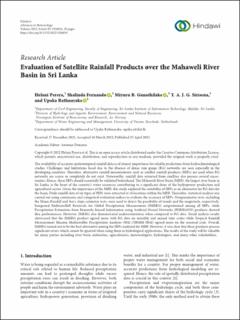| dc.description.abstract | The availability of accurate spatiotemporal rainfall data is of utmost importance for reliable predictions from hydroclimatological studies. Challenges and limitations faced due to the absence of dense rain gauge (RG) networks are seen especially in the developing countries. Therefore, alternative rainfall measurements such as satellite rainfall products (SRPs) are used when RG networks are scarce or completely do not exist. Noteworthy, rainfall data retrieved from satellites also possess several uncertainties. Hence, these SRPs should essentially be validated beforehand. The Mahaweli River Basin (MRB), the largest river basin in Sri Lanka, is the heart of the country’s water resources contributing to a significant share of the hydropower production and agricultural sector. Given the importance of the MRB, this study explored the suitability of SRPs as an alternative for RG data for the basin. Daily rainfall data of six types of SRPs were extracted at 14 locations within the MRB. Thereafter, statistical analysis was carried out using continuous and categorical evaluation indices to evaluate the accuracy of SRPs. Nonparametric tests, including the Mann-Kendall and Sen’s slope estimator tests, were used to detect the possibility of trends and the magnitude, respectively. Integrated MultisatellitE Retrievals for Global Precipitation Measurement (IMERG) outperformed among all SRPs, while Precipitation Estimation from Remotely Sensed Information using Artificial Neural Networks (PERSIANN) products showed dire performances. However, IMERG also demonstrated underestimations when compared to RG data. Trend analysis results showcased that the IMERG product agreed more with RG data on monthly and annual time scales while Tropical Rainfall Measurement Mission Multisatellite Precipitation Analysis–3B42 (TRMM-3B42) agreed more on the seasonal scale. Overall, IMERG turned out to be the best alternative among the SRPs analyzed for MRB. However, it was clear that these products possess significant errors which cannot be ignored when using them in hydrological applications. The results of the study will be valuable for many parties including river basin authorities, agriculturists, meteorologists, hydrologists, and many other stakeholders. | en_US |

